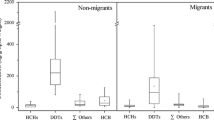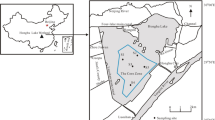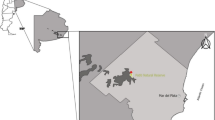Abstract
Despite recognition of the lack of reptile ecotoxicology data, the taxon remains poorly studied. Contaminant body burdens are useful in demonstrating exposures to contaminants do occur and may provide insight regarding risks. The purpose of this study was to determine organochlorine pesticide burdens in various tissues of terrestrial reptiles opportunistically collected in Arizona. Heptachlor, DDE, and endrin were the most common analytes detected in fat samples. Liver samples contained methoxychlor and heptachlor at greater frequency than other organochlorines. Investigations into chronic low-level exposures are rare for reptiles and research is needed to determine critical body residues associated with adverse impacts.
Similar content being viewed by others
References
Bergeron CM, Husak JF, Unrine JM, Romanek CS, Hopkins WA (2007) Influence of feeding ecology on blood mercury concentrations in four species of turtles. Environ Toxicol Chem 26:1733–1741
Best SM (1973) Some organoschlorine pesticide residues in wildlife of the Northern Territory, Australia, 1970–1971. Aust J Biol Sci 26:1161–1170
Brooks JE, Savarie PJ, Johnston JJ (1998) The oral and dermal toxicity of selected chemicals to brown tree snakes (Boiga irregularis). Wildl Res 25:427–435
Campbell KR, Campbell TS (2002) A logical starting point for developing priorities for lizard and snake ecotoxicology: a review of available data. Environ Toxicol Chem 21:894–898
Fleet RR, Clark DR Jr, Plapp FW Jr (1972) Residues of DDT and dieldrin in snakes from two texas agro-systems. Bioscience 22:664–665
Gibbons JW, Scott DE, Ryan TJ et al (2000) The global decline of reptiles, déjà vu amphibians. Bioscience 50:653–666
Hela DG, Konstantinou IK, Sakellarides TM, Lambropoulou DA, Akriotis T, Albanis TA (2006) Persistent organochlorine contaminants in liver and fat of birds of prey from Greece. Arch Environ Contam Toxicol 50:603–613
Hopkins WA (2000) Reptile toxicology: challenges and opportunities on the last frontier in vertebrate ecotoxicology. Environ Toxicol Chem 19:2391–2393
Hopkins WA, Roe JH, Snodgrass JW, Staub BP, Jackson BP, Congdon JD (2002) Effects of chronic dietary exposure to trace elements on banded water snakes (Nerodia fasciata). Environ Toxicol Chem 21:906–913
Milnes MR, Guillette LJ Jr (2008) Alligator tales: new lessons about environmental contaminants from a sentinel species. Bioscience 57:1027–1036
Punzo F, Laveglia J, Lohr D, Dahm PA (1979) Organochlorine insecticide residues in amphibians and reptiles from Iowa and lizards from the Southwestern United States. Bull Environ Contam Toxicol 21:842–848
Rainwater TR, Reynolds KD, Canas JE, Cobb GP, Anderson TA, McMurry ST, Smith PN (2005) Organochlorine pesticides and mercury in cottonmouths (Agkistrodon piscivorus) from northeastern Texas, USA. Environ Toxicol Chem 24:665–673
Rauschenberger RH, Wiebe JJ, Buckland JE, Smith JT, Sepulveda MS, Gross TS (2004) Achieving environmentally relevant organochlorine pesticide concentrations in eggs through maternal exposure in Alligator mississippiensis. Mar Environ Res 58:851–856
Shen L, Wania F, Lei YD, Teixeira C, Muir DCG, Bidleman TF (2005) Atmospheric distribution and long-range transport behavior of organochlorine pesticides in north America. Environ Sci Technol 39:409–420
Sparling DW, Linder G, Bishop CA, Krest SK (2010) Recent Advancements in amphibian and reptile ecotoxicology. In: Sparling DW, Linder G, Bishop CA, Krest SK (eds) Ecotoxicology of Amphibians and Reptiles, 2nd edn. SETAC Press, Pensacola, pp 1–11
Talent LG, Dumont JN, Bantle JA, Janz DM, Talent SG (2002) Evaluation of western fence lizards (Sceloporus occidentalis) and eastern fence lizards (Sceloporus undulatus) as laboratory reptile models for toxicological investigations. Environ Toxicol Chem 21:899–905
Ware GW (1974) Ecological history of DDT in Arizona. J Ariz Acad Sci 9:61–65
Weir SM, Suski JG, Salice CJ (2010) Ecological risk of anthropogenic pollutants to reptiles: evaluating assumptions of sensitivity and exposure. Environ Pollut 158:3596–3606
Acknowledgments
SMW was provided funding from the Helen Jones Foundation. The authors wish to acknowledge numerous student and research assistants from the Goode Lab for help in collecting and preparing specimens, in particular Chip Cochran who did most of the tissue preparation from dead animals. We thank the following companies and individuals for their assistance/permission during field works: Vistoso Partners LLC and Dick Maes, Todd Huizinga and staff at Stone Canyon Golf Course, and the staff at Arizona National Golf Course. The Arizona Game and Fish Heritage Fund provided multiple grants supporting this work. We thank the National Fish and Wildlife Foundation Wildlife Links Program sponsored by the United States Golf Association. We also thank Larry Norris of the National Park Service and the Desert Southwest Cooperative Ecosystems Study Unit, University of Arizona. Finally, we acknowledge the Faculty Small Grant and Green Fund Award, University of Arizona. The findings and conclusions in this article are those of the authors and do not necessarily represent the views of the U.S. Fish and Wildlife Service.
Ethical standards
The authors declare that the experiments conducted in the current study comply with the current laws of the United States.
Conflict of interest
The authors declare that they have no conflict of interest.
Author information
Authors and Affiliations
Corresponding author
Rights and permissions
About this article
Cite this article
Weir, S.M., Dobrovolny, M., Torres, C. et al. Organochlorine Pesticides in Squamate Reptiles from Southern Arizona, USA. Bull Environ Contam Toxicol 90, 654–659 (2013). https://doi.org/10.1007/s00128-013-0990-y
Received:
Accepted:
Published:
Issue Date:
DOI: https://doi.org/10.1007/s00128-013-0990-y




